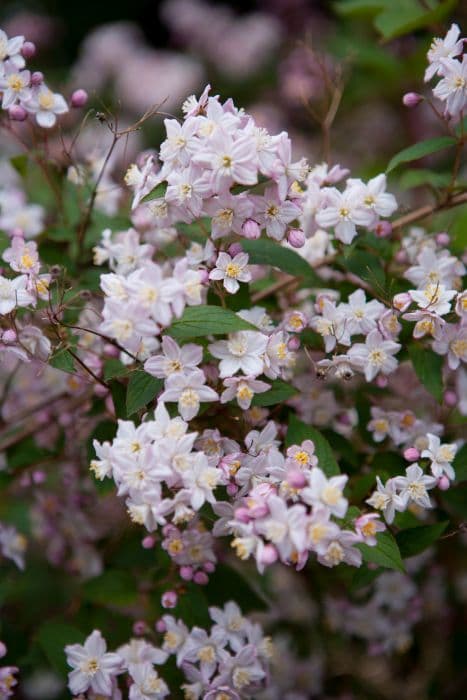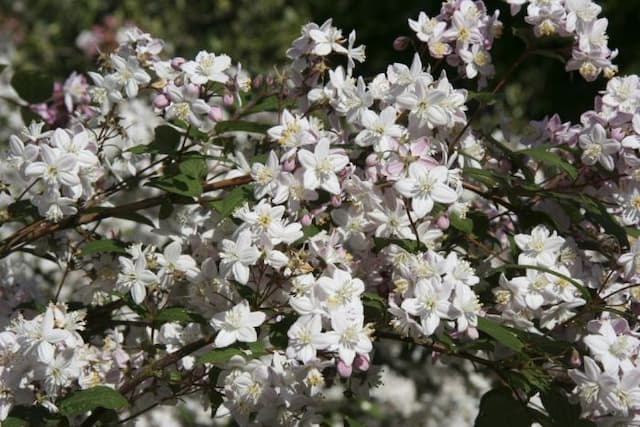Lacecap Hydrangea Hydrangea macrophylla 'Zorro' (PBR) (L)

ABOUT
Hydrangea macrophylla 'Zorro' (PBR) (L), commonly known as Lacecap Hydrangea, is a deciduous shrub that boasts a striking appearance. This ornamental plant is characterized by its large, rounded flower heads which have a two-tiered composition. The center of these striking blooms is filled with tiny, fertile flowers that are typically quaint and of a subdued color. Surrounding these are the showier, larger sterile florets, which are often vibrant and command attention. These sterile florets usually have an attractive, slightly serrated edge and can come in a range of colors from deep blue to pink, depending on soil acidity. The Lacecap Hydrangea 'Zorro' has dark green leaves with a glossy appearance, which serve as a beautiful backdrop to the vivid flowers. The foliage often takes on a rich, burgundy hue as summer transitions into autumn, adding a layer of visual interest to the plant. The stems supporting this lush greenery stand out with their distinctive dark coloration, sometimes described as almost black, which further accentuates the brightness of the blooms and foliage. These strong, sturdy stems ensure that the heavy flower heads are well-supported above the foliage, creating an appearance that is both robust and elegant. Overall, the Lacecap Hydrangea 'Zorro' is a splendid addition to any garden or landscape, prized for its luscious flowers and the transformation in leaf color as the seasons change. This plant brings a splash of color and a dramatic flair wherever it is grown, making it a favorite among garden enthusiasts.
About this plant
 Names
NamesFamily
Hydrangeaceae.
Synonyms
Bigleaf Hydrangea, French Hydrangea, Lacecap Hydrangea, Mophead Hydrangea, Hortensia.
Common names
Hydrangea macrophylla 'Zorro' (PBR) (L)
 Toxicity
ToxicityTo humans
Hydrangea, including the variety Hydrangea macrophylla 'Zorro', can be toxic to humans if ingested. The plant contains compounds such as hydrangin, which is a cyanogenic glycoside. When ingested, it can release cyanide in the body and potentially cause poisoning. Symptoms of hydrangea poisoning may include stomach upset, nausea, vomiting, and diarrhea. In severe cases, it may also lead to more serious symptoms such as dizziness, confusion, or increased heart rate. Although serious incidents are rare, it is advised to seek medical attention if ingestion occurs and symptoms develop.
To pets
Hydrangea, including Hydrangea macrophylla 'Zorro', is toxic to pets, such as dogs and cats. The plant contains cyanogenic glycosides, which can release cyanide when chewed or ingested. Symptoms of hydrangea poisoning in pets can include vomiting, diarrhea, lethargy, and depression. In more severe cases, ingestion may lead to increased heart rate and symptoms of cyanide toxicity. Pet owners should prevent their animals from ingesting any part of the plant and seek veterinary care immediately if they suspect their pet has consumed hydrangea.
 Characteristics
CharacteristicsLife cycle
Perennials
Foliage type
Deciduous
Color of leaves
Green
Flower color
Varies
Height
3-5 feet (0.91-1.52 meters)
Spread
3-5 feet (0.91-1.52 meters)
Plant type
Shrub
Hardiness zones
5-9
Native area
Japan
Benefits
 General Benefits
General Benefits- Aesthetic Appeal: The 'Zorro' hydrangea offers stunning deep blue to pink flower heads, depending on the soil pH, enhancing the visual beauty of gardens.
- Landscaping Versatility: Able to grow in partial shade to full sun, this variety can fit into different landscape designs.
- Seasonal Interest: From late spring to early fall, this plant provides a long-lasting display of flowers.
- Attracts Pollinators: The flowers attract bees and butterflies, promoting biodiversity.
- Easy to Grow: The 'Zorro' hydrangea is known for being relatively easy to care for, requiring minimal maintenance.
- Hardiness: It is a hardy plant that can withstand cooler climates, making it suitable for many regions.
- Soil Adaptability: This hydrangea can adapt to a variety of soil conditions, though it prefers well-drained, moist soil.
- Pruning Resilience: It tolerates pruning well, which is helpful for maintaining size and shape.
 Medical Properties
Medical PropertiesThis plant is not used for medical purposes.
 Air-purifying Qualities
Air-purifying QualitiesThis plant is not specifically known for air purifying qualities.
 Other Uses
Other Uses- Alkaline pH Indicator: The color of the Hydrangea's flowers can indicate the pH level of the soil—blue in acidic soil and pink in alkaline. This property can be exploited for a rudimentary method of testing soil pH.
- Watercolor Dye: The vibrantly colored petals can be used to create a natural dye for watercolor painting, offering a range of hues from soft pinks to deep blues.
- Drying for Crafts: Hydrangea flowers, due to their full shape, dry beautifully and can be used in dried floral arrangements, wreaths, or potpourri.
- Garden Landscaping: Aside from its aesthetic appeal, Hydrangea can be strategically planted to create natural fencing or to delineate different zones within a garden.
- Floral Arrangements: Fresh cut Hydrangea flowers are a popular choice in wedding bouquets and centerpiece arrangements because of their large, lush blooms.
- Photography Prop: The plant can be used as an attractive background or focal point in garden photography due to its vibrant hues and full blossoms.
- Nature-Inspired Art: The diverse colors and shapes of the flowers can inspire patterns and designs for textiles, wallpapers, and other decorative arts.
- Culinary Garnish: While not for consumption, the blooms can serve as a beautiful edible-looking garnish for plating in high-end culinary presentations.
- Education and Research: Hydrangea can be used in horticultural studies and botany education due to its interesting soil pH-dependent color-changing properties.
- Winter Garden Interest: The dried flower heads of the Hydrangea can add texture and visual interest to gardens even in the winter months.
Interesting Facts
 Feng Shui
Feng ShuiThe Hydrangea is not used in Feng Shui practice.
 Zodiac Sign Compitability
Zodiac Sign CompitabilityThe Hydrangea is not used in astrology practice.
 Plant Symbolism
Plant Symbolism- Heartfelt Emotions: The Hydrangea, particularly the 'Zorro' variety, often symbolizes deep and heartfelt emotions due to its abundant flower heads and intense coloration.
- Gratitude: In some cultures, hydrangeas represent gratitude and thanksgiving, likely due to their lush and generous blooms.
- Understanding: The complexity of the Hydrangea's flowers, with numerous small individual blooms creating a larger head, is taken to embody understanding and patient empathy in relationships.
- Vanity: In certain contexts, hydrangeas may carry a more negative connotation of vanity or boastfulness, reflecting their showy appearance.
- Frigidity: The hydrangea sometimes represents frigidity or a lack of emotion, a meaning that contrasts with its more positive associations.
- Abundance: The fullness of the hydrangea's flower heads conveys a sense of abundance and prosperity.
- Fourth Wedding Anniversary: Hydrangeas are often associated with the fourth wedding anniversary, reflecting the themes of appreciation, abundance, and steadfastness meant to be nurtured by this stage in a marriage.
 Water
WaterLacecap Hydrangeas like Hydrangea macrophylla 'Zorro' should be watered deeply, ensuring the soil is moist but not soggy. During the growing season, water about 1 inch per week, either from rainfall or supplemental watering. This equates to about 0.623 gallons per square yard per week. Water directly at the base of the plant to keep moisture off the leaves and flowers. In hotter weather or if planted in containers, they may need more frequent watering to prevent the soil from drying out.
 Light
LightLacecap Hydrangeas thrive in a spot with morning sun and afternoon shade. Ideally, place them where they receive direct sunlight in the morning for a few hours, followed by dappled or partial shade in the afternoon. Too much direct afternoon sun can lead to leaf scorch, while too much shade can result in fewer blooms.
 Temperature
TemperatureLacecap Hydrangeas prefer a temperature range between 60°F and 75°F for optimal growth. They can survive in temperatures as low as 50°F but should be protected from frost, which can damage the buds and flowers. During hot summer days, temperatures above 80°F might stress the plant, so providing afternoon shade can be beneficial.
 Pruning
PruningPrune Lacecap Hydrangeas immediately after they finish blooming in summer, as they bloom on old wood. Pruning later in the year can remove the next season's flower buds. Remove old or dead wood and thin out crowded stems to encourage air circulation and new growth. You may also prune to shape the plant and maintain its size.
 Cleaning
CleaningAs needed
 Soil
SoilLacecap hydrangeas, like 'Zorro', thrive in rich, porous, moist soil with good drainage. A soil pH of around 5.5 is ideal for strong blue flower color, while a pH closer to 6.5 may lead to pinker blooms. The best soil mix is equal parts garden soil, peat moss, and perlite to ensure aeration and moisture retention.
 Repotting
RepottingLacecap hydrangeas should be repotted every 2-3 years or when they become root-bound. Use the opportunity to refresh the soil mix, trim old roots gently, and select a slightly larger pot to encourage continued growth.
 Humidity & Misting
Humidity & MistingLacecap hydrangeas prefer high humidity environments to thrive. Maintaining around 60-70% relative humidity is ideal for these plants, as it supports lush foliage and vibrant blooms.
 Suitable locations
Suitable locationsIndoor
Place in bright light, water well, and maintain high humidity.
Outdoor
Part shade, moist fertile soil, mulch roots, water regularly.
Hardiness zone
5-9 USDA
 Life cycle
Life cycleThe life cycle of the Hydrangea macrophylla 'Zorro', commonly known as lacecap hydrangea, begins with seed germination, which requires adequate moisture and light conditions. Upon germination, seedlings emerge and establish a rooting system; this juvenile phase involves growth of the main stem and foliage development in the first growing season. As the plant matures, it enters a vegetative state where it produces robust stems and large, lush leaves, and it continues to develop a more extensive root system. Following the vegetative stage, the lacecap hydrangea enters the flowering phase, typically in early to mid-summer, displaying its characteristic large, flat flower heads with a mix of showy and smaller flowers. After pollination by insects, the plant will produce seeds, completing its reproductive cycle. Finally, the plant enters a period of dormancy in the colder months, where growth ceases temporarily until conditions become favorable again in the spring.
 Propogation
PropogationPropogation time
Late spring to early summer
Propogation: The most favored method of propagating Hydrangea macrophylla 'Zorro', commonly known as Lacecap Hydrangea, involves softwood cuttings. This approach is ideally performed in the late spring to early summer when the plant's new growth is still tender and pliable. To propagate, a gardener would cut a 4 to 6 inch (about 10 to 15 cm) stem tip below a leaf node, remove the bottom leaves, and possibly dip the cut end into rooting hormone to encourage root development. The cutting is then planted in a pot filled with a well-draining soil mix and kept in a warm environment with high humidity and indirect sunlight. Roots typically establish in a few weeks, after which the young plant can be gradually acclimated to normal growing conditions and eventually transferred to the garden.








![Hydrangea [Early Sensation]](/_next/image?url=https%3A%2F%2Fplants-admin.emdemapps.com%2Fimages%2Fplants%2F%2Fimages%2F604b6150338db.png&w=640&q=75)
